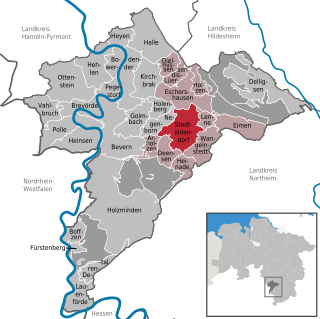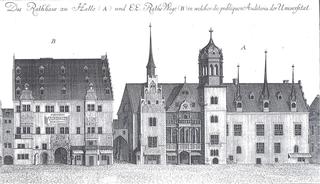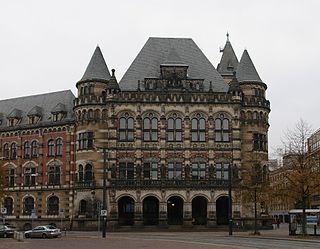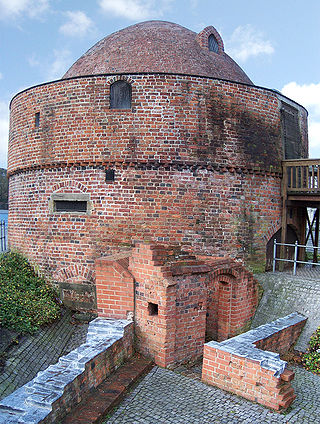
The Rotes Rathaus is the town hall of Berlin, Germany, located in the Mitte district on Rathausstraße near Alexanderplatz. It is the home to the governing mayor and the government of the state of Berlin. The name of the landmark building dates from the façade design with red clinker bricks.

Stadtoldendorf is a town in the center of the Holzminden district, Lower Saxony, Germany. Stadtoldendorf is the seat of the Samtgemeinde Eschershausen-Stadtoldendorf.

The New Town Hall is a town hall that forms the northern part of Marienplatz in Munich, Bavaria, Germany. It hosts the city government including the city council, offices of the mayors and a small portion of the administration. In 1874 the municipality had left the Old Town Hall for its new domicile.

Bremen City Hall is the seat of the President of the Senate and Mayor of Bremen, Germany. It is one of the most important examples of Brick Gothic and Weser Renaissance architecture in Europe. Since 1973, it has been a protected historical building. In July 2004, along with the Bremen Roland statue, the building was added to the list of UNESCO World Heritage Sites because of its outstanding architecture and its testimony to the development of civic autonomy in the Holy Roman Empire.

The Bremen Ratskeller is the council wine cellar of the Townhall of Bremen. Since it was erected in the year 1405, German wines were stored and sold there. With its history over 600 years the Ratskeller of Bremen is one of the oldest wine cellars of Germany, furthermore the oldest wine barrel of Germany, a wine from Rüdesheim which is dated 1653, is stored here.

The Old Town Hall, until 1874 the domicile of the municipality, serves today as a building for representative purposes for the city council in Munich, Bavaria, Germany. The Old Town Hall bounds the central square Marienplatz on its east side.

The City Hall is a historical building in Cologne, western Germany. It is located off Hohe Straße in the district of Innenstadt, and set between the two squares of Rathausplatz and Alter Markt. It houses part of the city government, including the city council and offices of the Lord Mayor. It is Germany's oldest city hall with a documented history spanning some 900 years. The history of its council during the 11th century is a prominent example for self-gained municipal autonomy of Medieval cities.

The Old Town Hall was a town hall in Halle (Saale), Germany.

The New Town Hall is a town hall on the Schlossplatz in Wiesbaden, Hesse, Germany. It hosts the city government including the city council, offices of the mayors and part of the administration. It was built between 1884 and 1887 by Georg von Hauberrisser in a Renaissance Revival architecture style. The basement is almost completely occupied by a restaurant called Ratskeller.

Altes Stadthaus in Dortmund, North Rhine-Westphalia, Germany, is an office block which was built in 1899, and was designed by "master builder" Friedrich Kullrich. It was built in the Renaissance Revival architecture (Neo-Renaissance) style. After the office block was severely damaged in World War II, it was rebuilt in a simplified form.

The New Town Hall has stood on the Domshof in the centre of Bremen, Germany since 1913. Located behind the Unser-Lieben-Frauen-Kirchhof cemetery, it is adjacent to the older section of the Town Hall with which it forms a harmonious ensemble. Among its sumptuous rooms decorated with local artefacts, the New Town Hall houses the Senate Chamber used by the Senate for its regular meetings and the Great Hall, a venue for official receptions. In 2004, Bremen Town Hall was listed as a UNESCO World Heritage Site, together with the Roland of Bremen, because of its outstanding architecture and testimony to the development of civic autonomy during the Holy Roman Empire.

The Landgericht Bremen is the courthouse of the State of Bremen on the Domsheide in the old town of Bremen, Germany. It was built in the late 19th century in the French Renaissance style and completed in 1906. It has been a listed building since 1992. In addition to the judicial services of the regional court, the building houses sections of the Public Prosecutor's department (Staatsanwaltschaft) and of the district court (Amtsgericht).

Unser Lieben Frauen Kirchhof is a central square in Bremen between the Bremer Marktplatz, Obernstraße, Sögestraße and the Domshof. The square is used as a flower market. The appearance of the square is quite consistent: sandstone, dark brick and clinker brick.

The Pulverturm is a historic brick-built powder magazine in the city of Oldenburg, Lower Saxony, Germany.

St. Lambert's Church is the main Evangelical Lutheran church in the centre of the city of Oldenburg, Lower Saxony, Germany.

The Haus "Graf Anton Günther" is a historic house in central Oldenburg, Germany, dating from 1682.

The Old Town Hall is a former, and the first, town hall in Hanover, Germany. Originally built in the old city district in 1410, replaced by the New Town Hall in 1913, and extensively restored in 1953 and 1964 after heavy bomb damage in World War II, it is the oldest secular building in the city. The market façade with the highly sophisticated Brick Gothic of the lucarnes has been preserved and partly restored in its medieval shape. Some elements of it were copied on other wings of the building.

The Town Hall of Freiburg im Breisgau, Germany, is spread over a total of 16 locations. The three most important buildings are the Old Town Hall and the New Town Hall in the city center as well as the Technical Town Hall in the Stühlinger district. The oldest town hall in Freiburg is part of the building complex of the Old Town Hall. It is located in the inner courtyard and is now called Gerichtslaube and is directly connected to the Old Town Hall. A passage from the New Town Hall to the Old Town Hall spans the Turmstraße between the two buildings. The three town halls form a complex, in which the three individual buildings are registered as monuments in the list of monuments of the country.
Altes Rathaus may refer to:

The Old Town Hall, which dominates the east side of the Markt square in Leipzig's district Mitte, is considered one of Germany's most important secular Renaissance buildings. At the rear is the Naschmarkt. The mayor and the municipal administration have been housed in the New Town Hall since 1905.



















